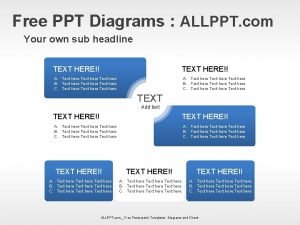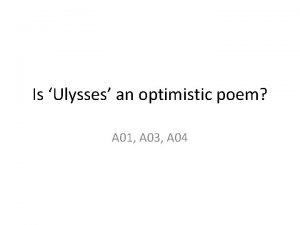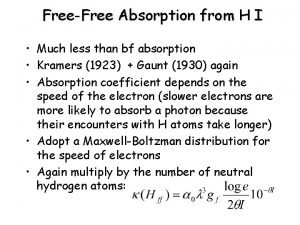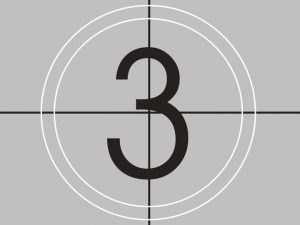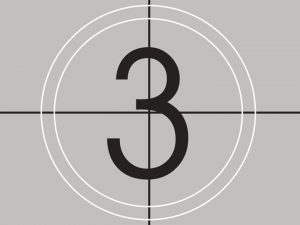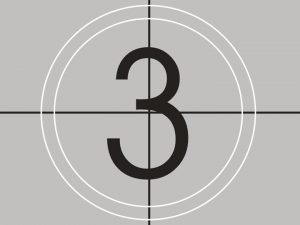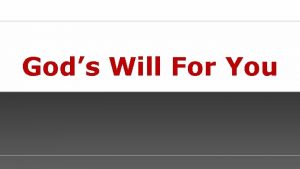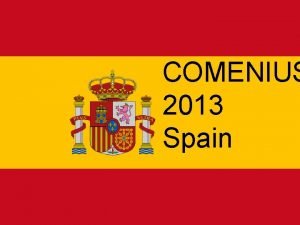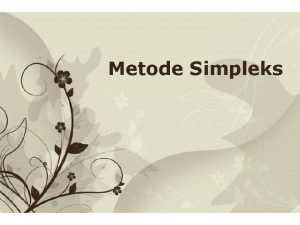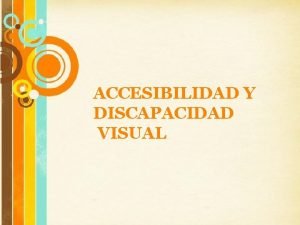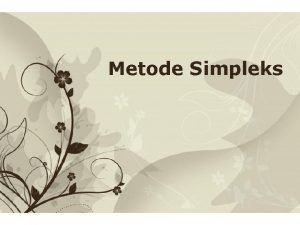IP Addressing Free Powerpoint Templates Page 1 IP































- Slides: 31

IP Addressing Free Powerpoint Templates Page 1

IP Addressing • IP Addressing is Logical Addressing • It works on Network Layer (Layer 3) • Two Version of Addressing Scheme – IP version 4 – 32 bit addressing – IP version 6 – 128 bit addressing – Free Powerpoint Templates Page 2

IP version 4 • What is BIT ? Bit is a value that will represent 0’s or 1’s (i. e. Binary) 0101000001011011111100000001 • 32 bits are divided into 4 Octets known as Dotted Decimal Notation First Octet Second Octet Third Octet Forth Octet 0101. 00000101. 10111111. 00000001 Free Powerpoint Templates Page 3

IP version 6 • 128 -bit address is divided along 16 -bit boundaries, and each 16 -bit block is converted to a 4 -digit hexadecimal number and separated by colons (Colon -Hex Notation) FEDC: BA 98: 7654: 3210: FEDC: BA 98: 7654: 3210 Free Powerpoint Templates Page 4

Binary to Decimal Conversion 27 0 0 0 Taking Example for First Octet : Total 8 bits, Value will be 0’s and 1’s i. e. 28 = 256 combination 26 25 24 23 22 21 20 0 0 0 = 0 0 0 0 1 = 1 Total IP Address Range 0 0 0 1 0 = 2 0. 0 0 0 1 1 = 3 to 0 0 1 0 0 = 4 1 1 255 1 1 1 = 255 Free Powerpoint Templates Page 5

IP Address Classes • Total IP Addressing Scheme is divided into 5 Classes • CLASS A • CLASS B LAN & WAN • CLASS C • CLASS D Multicasting & Newsgroups • CLASS E Research & Development Free Powerpoint Templates Page 6

Priority Bits Concept • To identify the range of each class we will be using Priority Bit Concept • Priority Bit is the left most bits in the First Octet • CLASS A priority bit is 0 • CLASS B priority bit is 10 • CLASS C priority bit is 110 • CLASS D priority bit is 1110 • CLASS E priority bit is 1111 Free Powerpoint Templates Page 7

CLASS A Range For Class A range reserved first bit in first octet, the value of that bit should not change. 0 xxxxxxxx. xxxx 27 0 0 0 26 0 0 0 25 0 0 0 24 0 0 0 23 0 0 0 22 21 0 0 0 1 1 0 20 0 1 0 = = = 0 1 1 1 = 127 1 0 1 2 3 4 Class A Range 0. 0 to 127. 255 Exception 0. X. X. X and 127. X. X. X network are reserved Free Powerpoint Templates Page 8

CLASS B Range For Class B range reserved first two bit in first octet, the value of that bit should not change. 10 xxxxxxxx. xxxx 27 1 1 1 26 0 0 0 25 0 0 0 24 0 0 0 23 0 0 0 22 21 0 0 0 1 1 0 20 0 1 0 = = = 1 0 1 1 1 = 191 1 128 129 130 131 132 Class B Range 128. 0. 0. 0 to 191. 255 Free Powerpoint Templates Page 9

CLASS C Range For Class C range reserved first three bit in first octet, the value of that bit should not change. 110 xxxxxxxx. xxxx 27 1 1 1 26 1 1 1 25 0 0 0 24 0 0 0 23 0 0 0 22 21 0 0 0 1 1 0 20 0 1 0 = = = 1 1 0 1 1 = 223 1 192 193 194 195 196 Class C Range 192. 0. 0. 0 to 223. 255 Free Powerpoint Templates Page 10

CLASS D Range For Class D range reserved first four bit in first octet, the value of that bit should not change. 1110 xxxxxxxx 27 1 1 1 26 1 1 1 25 1 1 1 24 0 0 0 23 0 0 0 22 21 0 0 0 1 1 0 20 0 1 0 = = = 1 1 1 0 1 1 1 = 239 1 224 225 226 227 228 Class D Range 224. 0. 0. 0 to 239. 255 Free Powerpoint Templates Page 11

CLASS E Range For Class E range reserved first four bit in first octet, the value of that bit should not change. 1111 xxxxxxxx 27 1 1 1 26 1 1 1 25 1 1 1 24 1 1 1 23 0 0 0 22 21 0 0 0 1 1 1 1 20 0 1 0 = = = 1 = 255 240 241 242 243 244 Class E Range 240. 0 to 255 Free Powerpoint Templates Page 12

Octet Format • IP address is divided into Network & Host Portion • CLASS A is written as N. H. H. H • CLASS B is written as N. N. H. H • CLASS C is written as N. N. N. H Free Powerpoint Templates Page 13

CLASS A Networks & Host • Class A Octet Format is N. H. H. H • Network bits : 8 Host bits : 24 • No. of Networks = 28 -1 (-1 is Priority Bit for Class A) = 27 = 128 – 2 (-2 is for 0 & 127 Network) = 126 Networks No. of Host = 224 – 2 (-2 is for Network ID & Broadcast ID) = 16777216 - 2 CLASS A = 16777214 Hosts/Network 126 Networks Free Powerpoint Templates & Page 14 16777214 Hosts/Nw

CLASS B Networks & Host • Class B Octet Format is N. N. H. H • Network bits : 16 Host bits : 16 • No. = = = of Networks 216 -2 (-2 is Priority Bit for Class B) 214 16384 Networks • No. = = = of Host 216 – 2 (-2 is for Network ID & Broadcast ID) 65536 - 2 CLASS B 65534 Hosts/Network 16384 Networks Free Powerpoint Templates & Page 15 65534 Hosts/Nw

CLASS C Networks & Host • Class C Octet Format is N. N. N. H • Network bits : 24 Host bits : 8 • No. = = = of Networks 224 -3 (-3 is Priority Bit for Class C) 221 2097152 Networks • No. = = = of Host 28 – 2 (-2 is for Network ID & Broadcast ID) 256 - 2 CLASS C 254 Hosts/Network 2097152 Networks Free Powerpoint Templates & Page 16 254 Hosts/Nw

Network & Broadcast Address • The network address is represented with all bits as ZERO in the host portion of the address • The broadcast address is represented with all bits as ONES in the host portion of the address • Valid IP Addresses lie between the Network Address and the Broadcast Address. • Only Valid IP Addresses are assigned to hosts/clients Free Powerpoint Templates Page 17

Example - Class A : N. H. H. H Network Address : 0 xxxxxxx. 00000000 Broadcast Address : 0 xxxxxxx. 11111111 Class A 10. 0. 0. 1 10. 0. 0. 2 10. 0. 0. 3 Network Address Valid IP Addresses 10. 255. 254 10. 255 Broadcast Address Free Powerpoint Templates Page 18

Example - Class B : N. N. H. H Network Address : 10 xxxxxx. 00000000 Broadcast Address : 10 xxxxxx. 11111111 Class B 172. 16. 0. 0 172. 16. 0. 1 172. 16. 0. 2 172. 16. 0. 3 Network Address 172. 16. 255. 254 172. 16. 255 Valid IP Addresses Broadcast Address Network Address Free Powerpoint Templates Page 19

Example - Class C : N. N. N. H Network Address : 110 xxxxxxxx. 0000 Broadcast Address : 110 xxxxxxxx. 1111 Class C 192. 168. 1. 0 192. 168. 1. 1 192. 168. 1. 2 192. 168. 1. 3 192. 168. 1. 254 192. 168. 1. 255 Network Address Valid IP Addresses Broadcast Address Network Address Free Powerpoint Templates Page 20

Private IP Address • There are certain addresses in each class of IP address that are reserved for LAN. These addresses are called private addresses. • They can be used for: home & office networks, ATM machines, networks not connected to Internet. Class A 10. 0 to 10. 255 Class B 172. 16. 0. 0 to 172. 31. 255 Class C 192. 168. 0. 0 to 192. 168. 255 Free Powerpoint Templates Page 21

Subnet Mask • Subnet Mask differentiates Network portion and Host Portion • Subnet Mask is been given for host Identification of Network ID • Represent all Network Bit Values with 1 • Represent all Host Bit Values with 0 Free Powerpoint Templates Page 22

What is Subnet ? • A portion of network – Which may be a physically independent network – Which share network address with other portion of bigger network Free Powerpoint Templates Page 23

What is subnetting ? • • Subnetting is essentially the modification of a singal IP network to create two or more logical visible sub section. It achieve by usesing bits from host portion of the IP address & reserves them to define a Subnet address Free Powerpoint Templates Page 24

When subnetting is necessary. • • Subnetting is required when one netwrok number needs to be distribute across multiple LAN segement. Hosts which dominate most of the LAN bandwidth need to isolated. Free Powerpoint Templates Page 25

The Fast Way: Subnetting • How many subnets? 2 x = number of subnets. x is the number of masked bits, or the 1 s. • How many hosts per subnet? 2 y – 2 = number of hosts per subnet. y is the number of unmasked bits, or the 0 s. – You need to subtract two for the subnet/network address and the broadcast address, which are not valid hosts. • What are the valid subnets? 256 – subnet mask = block size, or increment number. • What’s the broadcast address for each subnet? – the broadcast address is always the number right before the next subnet. • What are the valid hosts? – These are the numbers between the subnet and broadcast address. Free Powerpoint Templates Page 26

Class C network of 204. 15. 5. 0/24 • • You can start by looking at the subnet requirement. In order to create the five needed subnets you would need to use three bits from the Class C host bits. Two bits would only allow you four subnets (22). Since you need three subnet bits, that leaves you with five bits for the host portion of the address. How many hosts will this support? 25 = 32 (30 usable). This meets the requirement. Free Powerpoint Templates Page 27

Contt. . • • • net. A: 204. 15. 5. 0/27 net. B: 204. 15. 5. 32/27 net. C: 204. 15. 5. 64/27 net. D: 204. 15. 5. 96/27 net. E: 204. 15. 5. 128/27 Host address range 1 to 30 Host address range 33 to 62 Host address range 65 to 94 Host address range 97 to 126 Host address range 129 to 158 Free Powerpoint Templates Page 28

VLSM-Variable Length Subnet Mask • • In all of the previous examples of subnetting you will notice that the same subnet mask was applied for all the subnets. This means that each subnet has the same number of available host addresses. You may need this in some cases, but, in most cases, having the same subnet mask for all subnets ends up wasting address space. For example, in the solution above, a class C network was split into eight equal-size subnets; however, each subnet did not utilize all available host addresses, which results in wasted address space. The figure below illustrates this wasted address space. Free Powerpoint Templates Page 29

VLSM • Variable Length Subnet Masks (VLSM) allows you to use different masks for each subnet, thereby using address space efficiently. • • • net. A: 204. 15. 5. 0/27 net. B: 204. 15. 5. 32/27 net. C: 204. 15. 5. 64/27 net. D: 204. 15. 5. 96/27 net. E: 204. 15. 5. 128/27 Free Powerpoint Templates Page 30

VLSM • • • net. A: requires a /28 (255. 240) mask to support 14 hosts net. B: requires a /27 (255. 224) mask to support 28 hosts net. C: requires a /30 (255. 252) mask to support 2 hosts net. D*: requires a /28 (255. 240) mask to support 7 hosts net. E: requires a /27 (255. 224) mask to support 28 hosts Solution : --net. B: 204. 15. 5. 0/27 host address range 1 to 30 net. E: 204. 15. 5. 32/27 host address range 33 to 62 net. A: 204. 15. 5. 64/28 host address range 65 to 78 net. D: 204. 15. 5. 80/28 host address range 81 to 94 net. C: 204. 15. 5. 96/30 host address range 97 to 98 Free Powerpoint Templates Page 31
 Allppt download
Allppt download Allppt free
Allppt free Islamic background ppt
Islamic background ppt Allppt gratis
Allppt gratis Allpp
Allpp Usu powerpoint template
Usu powerpoint template Free real estate powerpoint templates
Free real estate powerpoint templates Allppt powerpoint
Allppt powerpoint Free elearning templates for powerpoint
Free elearning templates for powerpoint Powerpoint templates free
Powerpoint templates free Http://www.free-powerpoint-templates-design.com
Http://www.free-powerpoint-templates-design.com Allppt
Allppt Flat addressing vs hierarchical addressing
Flat addressing vs hierarchical addressing Marketo velocity
Marketo velocity Powerpoim
Powerpoim Www.brainybetty.com
Www.brainybetty.com Click here to download
Click here to download Are sikhs vegetarian
Are sikhs vegetarian Powerpoint templates
Powerpoint templates Free call to action templates
Free call to action templates Essay header apa
Essay header apa Strategic map template
Strategic map template Fact and opinion powerpoint
Fact and opinion powerpoint Electromagnetic waves ppt template
Electromagnetic waves ppt template Gibbs free energy non standard conditions
Gibbs free energy non standard conditions Gibbs free energy
Gibbs free energy How to find t in gibbs free energy
How to find t in gibbs free energy Allocation map
Allocation map Helmholtz free energy and gibbs free energy
Helmholtz free energy and gibbs free energy Happy isles ulysses
Happy isles ulysses The story of an hour summary
The story of an hour summary Free-free absorption
Free-free absorption











